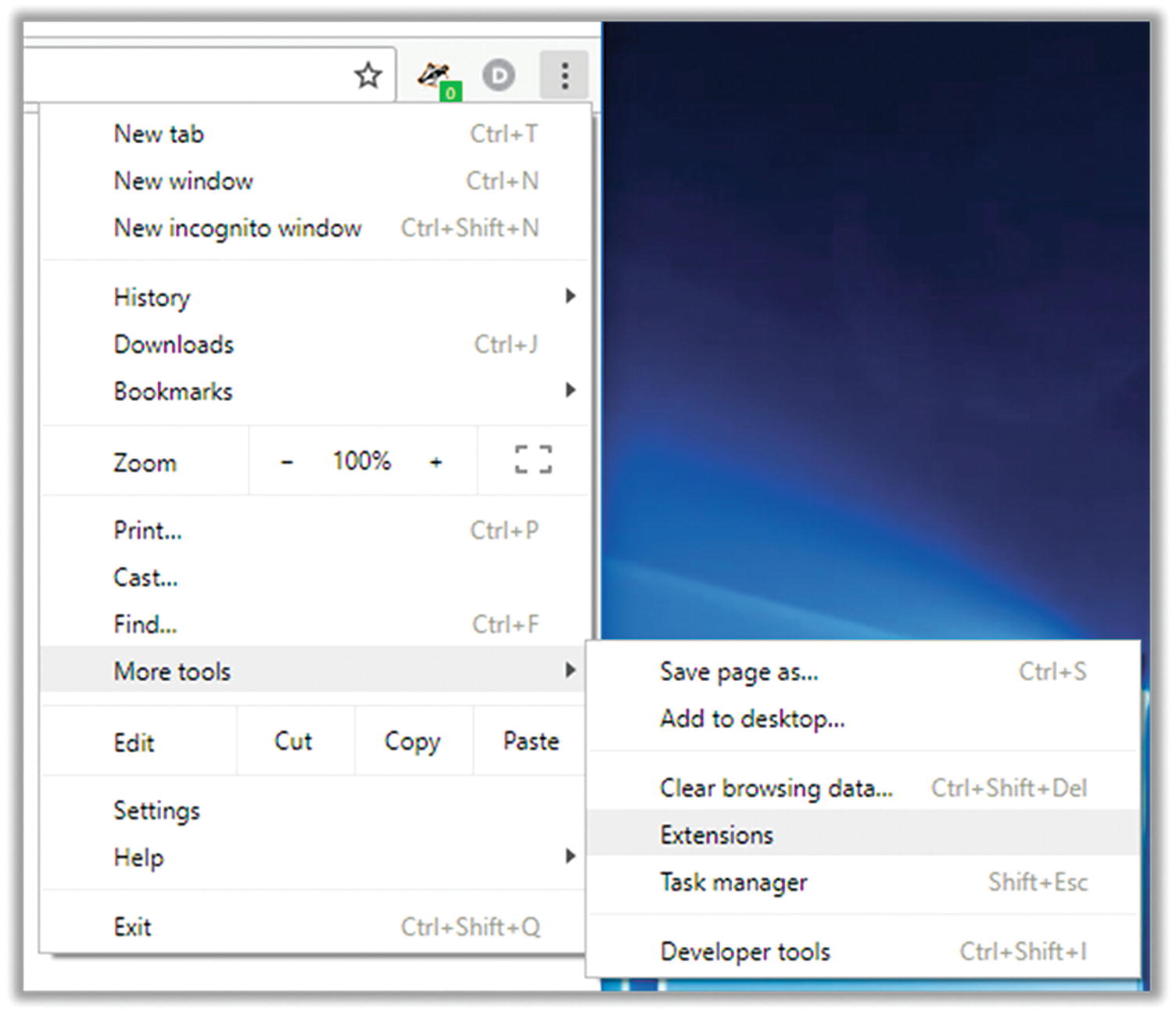It’s hard to believe that the World Wide Web is more than 25 years old. While technically launched in 1991 by Tim Berners-Lee, most people didn’t really know about it until the mid-1990s. The Web as we know it today really took off in the late 1990s with the “dot-com” boom and subsequent bust. We’ve come a long way since the early days of Mosaic and Netscape Navigator (the first popular web browsers). Web pages have gone from simple blocks of text and hyperlinks to amazingly powerful and complex web sites that can do just about anything. Many of the tasks that were relegated to heavyweight software applications like Photoshop and Microsoft Office are now moving into “the cloud.” With high-speed Internet connections and powerful new web technologies, there’s so much you can now do within the confines of your web browser. In fact, Google has a whole operating system called Chrome OS that is essentially a web browser that acts as a full-fledged desktop operating system. (This OS is the basis for the popular and inexpensive Chromebook laptops.)
Much of what we do today on our computers is surfing the Web. (I must admit I never understood that phrase…wouldn’t you be crawling a web? Or even getting stuck in a web? But surfing? I guess it makes as much sense as “channel surfing,” which is probably where we got the term.) So, in this chapter we’re going to learn about how to surf safely.
The way we access the Internet directly is usually with a web browser. Therefore, we need to find a good one—and by “good” I mean safe, not just full of whiz-bang features. Microsoft and Apple each have their own browsers that come with their operating systems: Internet Explorer or Edge on Windows and Safari on Mac OS. And because most people take the path of least resistance, these default web browsers tend to be popular on their respective platforms.1 However, there are better choices out there, and in this chapter I will help you choose the one that’s best for you.
Because web browsers have become the portal to the Internet, the bad guys have focused a lot of time and attention on finding ways to track, scam, and even infect you via this magical gateway. The functionality of a web browser can be extended in many ways, including plugins, extensions, and add-ons. I will help you figure out which of these are good, which are bad, and which are just plain ugly.
Before we get into those specifics, let’s dig a little deeper into how security works on the Web. This is going to sound rather technical, but it’s important to understand the basics at a high level. Don’t worry too much about the acronyms in this chapter—you don’t need to memorize them. But I want to get the terms out there in case you’ve seen them before or run into them in the future. The real key thing to take away here is the general “web of trust” concept that forms the basis for our current Internet security scheme.
Recall that all your computer communications (in both directions) are chopped up into small packets and shipped out over a massive web of interconnected computers. The packets will take many hops before they reach their destination, and each packet could take a slightly different path—it doesn’t really matter, as long as they all reach their destination. Previously in this book, we discussed the basic issues that we need to address when trying to communicate securely over the Internet. First, we need to somehow ensure that the person or web site we’re communicating with is actually who they say they are. Second, we would like our communications to be completely private—that is, we don’t want anyone between us and our intended recipient to be able to read what we’re saying or what data we’re exchanging. Finally, we would also like to know that the messages haven’t been tampered with along the way (you don’t have to be able to read something in order to alter it).
The way we secure Internet communications and authenticate third parties is using a technology called Transport Layer Security (TLS).2 TLS is used all over the place today to secure all sorts of communication, including digital phone calls, file transfers with cloud storage providers, and, of course, web surfing. When TLS is added to regular web communications via a browser, we move from “HTTP” to “HTTPS”—the added S stands for “secure.” When you are connected to a web site via HTTPS, you should see a little lock icon to the left of the web address that indicates that the connection is secure. Most of this happens automatically behind the scenes. Your web browser and the server at the far end do some quick negotiation, and when both sides are capable of using TLS , they establish a secure connection.
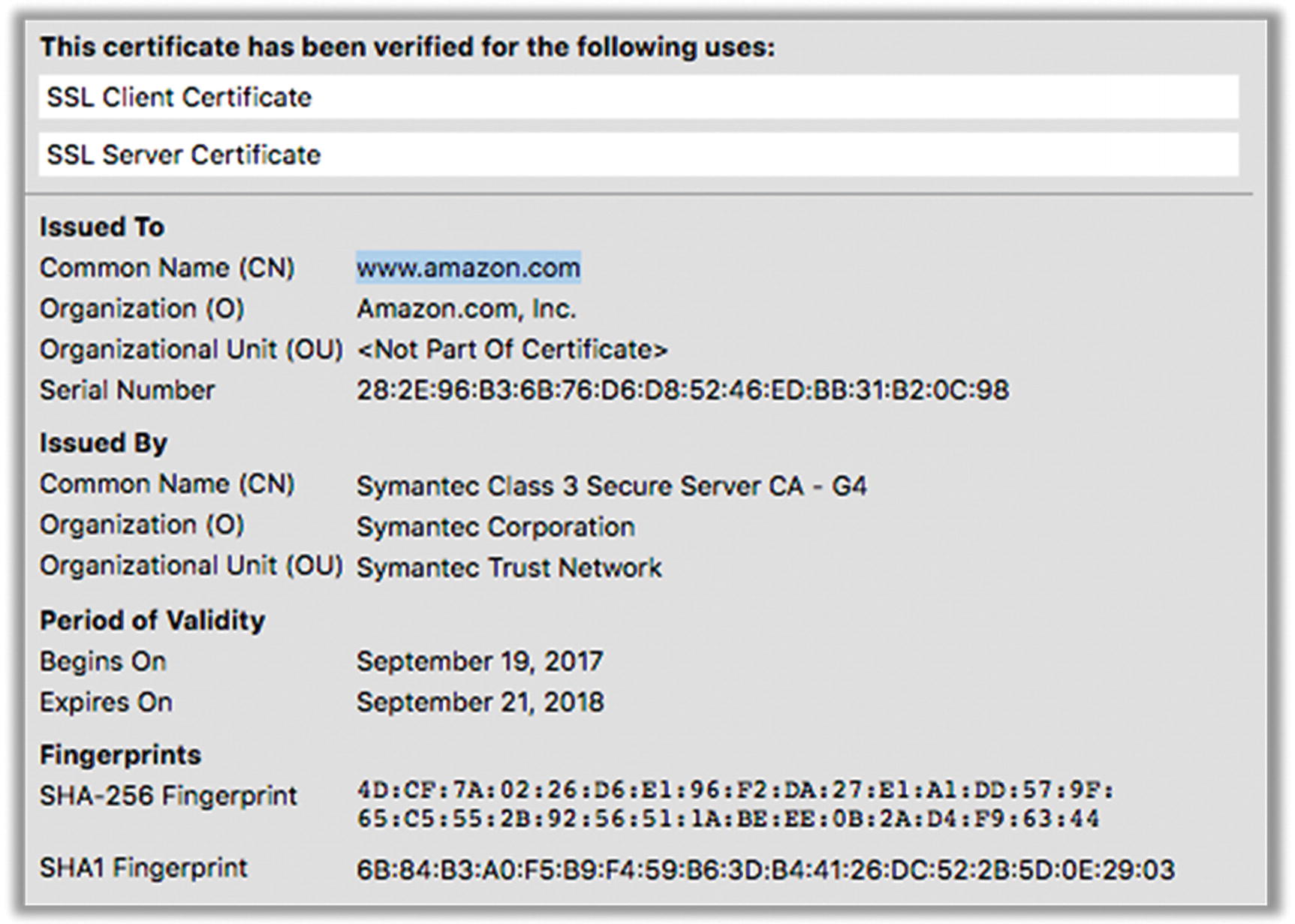
Sample certificate
There are three levels of certification and therefore three types of certificates: domain validation (DV), organization validation (OV), and extended validation (EV). The EV certificate (or cert) is the Cadillac model. As you might expect, the requirements to obtain an EV cert are more stringent, which generally means that you can trust them more than regular domain and organizational certs.
Once the CA issues a cert to the owner of the web site, the web site provides the cert as proof of identity when establishing a secure connection. This is like showing your driver’s license when buying booze to prove that you are who you say you are and that you’re old enough to buy alcoholic beverages. (An EV cert might be more like a passport.)
But wait... driver’s licenses can be faked. What about certificates? Well, I’ve got good news, and I’ve got bad news. The good news is that because certificates use solid cryptographic methods for creation, CA-backed certs can’t really be forged. While it’s possible to create “self-signed” certificates, no one is going to trust it for anything important. Web browsers have a built-in list of certificate authorities that they trust, and Joe Blow is not going to be on that list—just like liquor shops would only accept driver’s licenses from the 50 U.S. states and they probably have a folder that shows what each state’s license should look like. Creating a self-signed certificate is like printing up a homemade ID card on your printer and laminating it. Sure, it looks nice, but it’s not going to get you into a bar. Self-signed certificates can be used to properly encrypt communications; you just can’t be sure who it is you’re talking to.
So, that’s the good news. The bad news is that there are other ways to get a certificate that are arguably worse. Creating a trustworthy certificate is a crucial task, so you’d think we would limit this job to a select few organizations that we can all agree to trust. In practice, there are hundreds of certificate authorities in the world, including the Hong Kong Post Office (I’m not kidding). Any one of these CAs can issue a completely authentic certificate that contains nothing but lies, if they choose to. We trust them not to do this, but if they “go rogue” or if they get hacked, it’s possible for bad guys to get perfectly legitimate certificates that will allow them to impersonate Google or Yahoo or whoever they want. It would be like getting your “fake ID” directly from the Department of Motor Vehicles... it would be fake only in the sense that it contained wrong information, but it’s a perfectly valid driver’s license that would pass any examination.
As bad as this sounds, in practice this is not easy to do. You’re not worried about average teenager hackers in this situation; you’re worried about highly skilled and well-funded attackers, probably backed by a government or a big corporation. The target in this case would mostly be information (espionage). Also, there are other safeguards in place that mitigate the risk of being duped by one of these bad certs. For one thing, even if the bad guys get their hands on one of these mendacious certs, they still have to somehow get between you and your target server. This is a “man-in-the-middle” attack, which we discussed earlier—they insert themselves in the communication channel and pretend to be the other side to each end. That is, you establish communications with them, and then they turn around and establish communications with Amazon.com, let’s say. To you, they appear to be Amazon.com; to Amazon.com, they appear to be you. To do this, they need to somehow redirect you to the false web site instead of the real one. When you type amazon.com into your web browser, it uses the Domain Name Service (DNS) to figure out where your request really needs to go on the Internet—that is, the IP address of Amazon’s web server. Unless you can somehow also intercept that DNS lookup and provide a hacked reply, then the user will still be connected to the real Amazon web site. Also, there are new technologies coming online that will make this even more difficult in the near future (like Google’s Certificate Transparency3 project). So, while there are definite problems with the current CA-based system, it still works very well for the vast majority of web surfers, and other safeguards are being put in place to make it much harder to thwart or subvert.
So, if we can assume that the certificate system works (which is, as we’ve said, a significant “if”), then we can assume that when we establish an HTTPS connection to another web site that a) we can believe they are who they say they are and b) no one else can eavesdrop on our communications.
There’s one last—but crucial—point here. When you see that lock symbol on your web browser, that means your traffic is encrypted and that the certificate used by the web site is valid. That’s all. It doesn’t mean you can trust the web site. You can now get free domain validation certificates thanks to an effort by a large consortium of companies called Let’s Encrypt. That’s great—it makes it much easier for mom-and-pop companies to offer secure communications to their web site. But the bad guys can also use this free service to obtain a valid certificate for a malicious web site. So, the lock icon doesn’t mean the web site you’re on is trustworthy; it only means that no one else can spy on your communications with them.
Again, don’t worry about remembering all the technical details. All you really need to remember here is that HTTPS connections are secure. Many web sites are moving to HTTPS for all communications, which is a good thing, because everything we do on the Internet should be safe from prying eyes, even simple stuff. In the next section, we’ll take a look at just how pervasive web tracking has become.
Tracking Tech
While secure communications are vitally important, we have to also address the elephant in the room: web tracking. The amount of information you divulge every time you use a web browser is absolutely staggering: what web sites you visit, how long you stay on a given web site, how you got to that web site (i.e., which site you just came from), whether you bought something on a given web site, what ads you saw, what links you clicked, and even how much you spent while there. There has been a lot of debate on the value of this “metadata,” but the proof is in the pudding, as they say. These companies wouldn’t be bending over backward to get this info if it wasn’t making them money. And just in case you think it’s only retailers that are trying to find the right way to hook you into buying that spiffy new TV or anti-aging cream, you should also know that the politicians are using this data to find sympathetic potential voters and even to identify voters who might be convinced to switch sides. The recent scandal involving Facebook and Cambridge Analytica is a shining example.
This data is often used to specifically tailor a web site just for you—and not in a good way. For example, if the retailer happens to know that you’re wealthy or that you’re a heavy online shopper, they can actually make sure to show you the more expensive products first—in fact, they may even raise the prices4—if not based on your information specifically, perhaps based on whether you appear to be from a wealthy area.
The Webs We Weave
Most people just don’t realize how wide and vast this tracking network really is. The best way I know to explain the pervasiveness of web tracking to you is to use a nifty little web tool called Lightbeam .5 When you go to a web site, the content you see is often provided by multiple different companies. In addition to the first-party site (the web site you actually intended to visit), there are often many other third-party web sites that provide ads and other images—and also track what you’re doing. To see these third-party relationships, Lightbeam draws a graph that shows you all the third-party sites that are associated with the first party site you visited. (I know, all this “party” stuff sounds like legalese. It sorta makes your brain want to tune it out. But bear with me here.)

Wikipedia graph
In Figure 7-2, you’ll see the first-party site as a circle—in this case, the one with a W in it, which is wikipedia.org. The little white triangle next to that is a third-party web site that is associated with the site we visited. However, in this case, the third-party site is just wikimedia.org, which is directly associated with Wikipedia (that is, it’s not a third-party advertising or tracking site). It’s not uncommon for the third-party sites to just be extensions of the first-party site, and it’s also not uncommon for the third-party sites to be perfectly normal other web sites that provide things like web tools, images, and other harmless content. However, many of them are marketing firms and other “Big Data” companies whose sole purpose is to build a portfolio on you.

Wikipedia + Yahoo graph
Our little graph (Figure 7-3) has now grown substantially. While Yahoo.com was our primary target (the white circle with the Y in it), we can see that we’ve also triggered five other sites, only two of which are associated with Yahoo itself. The others are all tracking sites, including doubleclick.net and agkn.com. Note that there is no intersection here—no common third parties. Wikipedia—since it doesn’t track you—is actually pretty boring in this regard, so from here on, we’ll just cut them out of our picture.

Yahoo + Amazon graph
You can see in Figure 7-4 that loading Amazon’s web site also caused you to communicate with eight other third-party web sites. At least three of those sites were associated directly with Amazon (even though there’s no A logo on them like in the circle). Note that two of the third-party sites were also associated with Yahoo. Those are tracking sites. And they now know that you went to Yahoo and then to Amazon, and they quite likely know a lot about what you did there. Starting to get the idea?

Yahoo + Amazon + Dictionary graph
The graph in Figure 7-5 is so crowded now that you can’t really even read it. It’s hard to tell, but there are 100 third-party web sites there. You’ve visited just four web sites so far. The triangles that have multiple connections are the tracking sites.
So, just exactly how is it that they track you? The details would make your eyes glaze over. It’s very technical, and the techniques are legion and myriad. But essentially it boils down to somehow marking you in a way that can later be recognized if they (or someone they know) see you again. These markers come in many forms. One of the most popular tracking devices is called a cookie. A cookie is a small bit of data that web sites give to your computer, asking your browser to save it off and then repeat it back to them later when they ask for it. This is sort of like a medical chart—the information is kept on you, and when you interact with another party, they look at it to refresh their memories of you. These cookies were originally used by the first-party web site to help keep track of your login, your personal preferences, your shopping cart contents, etc. However, third parties have used them to mark people as they move around to different web sites, tracking all sorts of stuff about you. That’s the key point here... first-party cookies are between you and the site you intended to visit, which tends to be mutually beneficial; third-party cookies are things you generally didn’t ask for and may not even be aware of, and it’s almost completely for the benefit of the third party.
Let’s try an analogy to explain how this works. Let’s assume that your local mall wants to gather information on the people who shop there, and all the merchants agree to participate in the program. It’s time for you to go Christmas shopping, so you park your car and walk in via the Macy’s door. As you walk through the door, a silent little blowgun shoots a sticky dart that attaches to your back. This dart contains a little homing beacon that puts out a unique identifier, specific to you. They don’t know who you are (yet), but they want to be able to distinguish you from all the other people wandering the mall. This ID is logged in a special computer system, along with a little note: “Customer 4372 entered mall via Macy’s East door on first floor.” This entry in the log automatically notes the time and date, as well. You walk through Macy’s and into the mall proper. As you do, you walk by another sensor that detects your tag: “Customer 4372 left Macy’s without buying anything.” Since the time of entry and time of departure were so close, they could probably also conclude that you didn’t even look at anything.
Now you walk into a jewelry store. You look around, find the perfect gift—a diamond tennis bracelet—and go to the register to buy it. Your entry to the store was of course logged, but now you’ve also made a purchase. They now know quite a bit more about you. If the store is trying to be nice, they may only log that you are a white male in his mid-50s who lives nearby (based on your credit card billing address) and that you bought an expensive piece of jewelry. From this, other retailers in the mall (who can see all of this information) may well assume that you are married and have an above-average income level.
You leave the jewelry store and head down to Victoria’s Secret, where you make a very different purchase on a rarely used credit card. Marketing data analysis may suggest that you have not just a wife but also a mistress. You now walk into an electronics store. The store personnel can see from your records that you’re in a buying mood today and you have plenty to spend, so they ignore other customers who show less promise and focus on you. They steer you to higher-end equipment, and given that you probably have a wife, they test your interest in kitchen appliances and push hard for you to get a store credit card.
This is all just from a single trip to the mall. Think about all the other places you’ve been and purchases you’ve made—what could they tell about you? How detailed would your profile be? And would you want that profile to be shared with every store you walk into?
The key here is that all the stores have contracted with the same tracking company. They have a common set of sensors that are all networked together, creating a central place to log your activity. While you might think it’s entirely reasonable for a given store to keep information on previous buying and shopping activity, how do you feel knowing that information is being shared with many other retailers (and credit bureaus, potential employers, insurance companies, and so on)? It may be that this tracking company hordes the juiciest bits of information and gives only partial information to each store owner (depending on what level of service they’ve paid for). But it’s important to realize that even with the best of intentions, the fact of the matter is that that information exists somewhere—and therefore it can be stolen, abused, or even compelled by the government.
Enter the Panopticon
But we’re just getting started! There are several other tracking mechanisms, as well. People have gotten wise to the third-party cookie tracking method and have learned how to block them, so marketing companies have come up with other ways to track you—ways that can be difficult to avoid. Installing things like toolbars and social media extensions in your browser can give them access to all sorts of info. Even those social media buttons such as Facebook’s Like, Pinterest’s Pin It, and Twitter’s Tweet can be used to track you—even if you don’t click them! Sometimes they use tiny little one-pixel images with unique names... when you load that image, they know you’ve been there. Sometimes they use invisible web form fields. The list goes on and on, and the exact techniques change all the time.
Some really clever folks have figured out ways to “fingerprint” your web browser. To help web sites present themselves optimally, your web browser gives up all sorts of general information about your computer and web browser configuration: what plugins you have installed (even if they’re disabled), all the fonts you have on your computer, computer screen dimensions, what type of operating system you’re running, and what type of browser you have. The idea behind browser fingerprinting is that few people will have the same combination of these items.
Unlike regular cookies and other forms of tracking, there is no way to know that browser fingerprinting is happening to you, and it’s very hard to prevent. It’s just not easy to disguise yourself as you traverse the Internet. In this case, your best defense would be to look like everyone else—blend into the crowd. Unfortunately, many of the measures you might take to increase your online security and protect your privacy also tend to make you stand out because so few of us take the time to install these tools. Finally, this is just one technique—if you combine this technique with others (even just looking at your IP address), it becomes difficult to hide your tracks.
By the way, the name Panopticlick is based on an 18th century surveillance and behavioral conformance concept dubbed a Panopticon . An English philosopher by the name of Jeremy Bentham pioneered the design of an institution in the shape of a circle. The residents would be in cells on the rim, facing in, and the guards would be in a watchtower in the center, with a view into all the cells. The genius of this design was that the watchees couldn’t see the watchers, and therefore they could never know for sure when they were being monitored. Even though a handful of watchmen couldn’t actually observe everyone at once, each inmate had to assume that they were being watched at any given moment. This effectively forced all inmates into constant compliance.
Automated License Plate Readers
You’re being tracked much more often in the physical world now, too. Several companies are now marketing systems that will use high-resolution video cameras to scan a scene to find all the license plate numbers it can see. The system records each plate number along with the time and place it was seen. These cameras are being mounted on utility poles, traffic lights, overpasses, and even police squad cars as they patrol. This information is hoovered up and shared with other agencies, creating a massive database of millions of cars. The timestamp and location information can be used to track where you go, identify your travel patterns, and even (potentially) track who you associate with. While this could obviously be useful finding who was near the scene of a crime and where those people live and work, it could just as easily be used to track an ex-wife, patrons of a gun show or a Planned Parenthood, or people attending a political protest. Now think about what happens when they upgrade from recognizing license plates to recognizing faces.
I know it sounds far-fetched, folks, but we are truly heading into an era of constant, global surveillance. Our “institution” is the Internet, and the watchmen are numerous. Unlike the 18th century, we have the computing power to actively monitor a large swath of the populace in real time. And with massive data storage facilities, like the one built by the NSA in Utah, our watchmen can record massive quantities of our Internet and cell phone activity, review it later at their leisure, and store it effectively forever.
Arguing that you don’t care about privacy because you have nothing to hide is no different than saying you don’t care about free speech because you have nothing to say. 6
On the Ethics of Ad Blocking
The business model for most of the Internet revolves around advertising, which in and of itself is not a bad thing. It may be an annoying thing, but passive advertising isn’t actually harmful. Passive advertising is placing ads where people can see them. And savvy marketers will place their ads in places where their target audiences tend to spend their time. If you’re targeting middle-aged men, you might buy ad space on fantasy football or car racing web sites, for example. If you’re targeting tween girls, you might buy ad space on any site that might feature something about Taylor Swift or Ed Sheeran. And if it stopped there, I don’t think many of us would object—or at least have solid grounds for objection. After all, this advertising is paying for the content we’re consuming. Producing the content costs money, so someone has to pay for it or the content goes away.
Unfortunately, online marketing didn’t stop there. On the Web, competition for your limited attention has gotten fierce. With multiple ads on a single page, marketers need you to somehow focus on their ad over the others. And being on the Internet (and not a printed page), advertisers are able to do a lot more to grab your attention. Instead of simple pictures, ads can pop up, pop under, flash, move around, or float over the articles you’re trying to read. Worse yet, ad companies want to be able to prove to their customers that they were reaching the right people and that those people were buying their product because this makes their ad services far more valuable, meaning they can charge more for the ads.
Enter the era of “active advertising.” Today, you’re not just watching ads—those ads are now watching you back. The code that displays these ads is tracking where you go and what you buy, building up profiles on you and selling those profiles to marketers without your consent. Furthermore, those ads use precious data on cell phones and take a lot of extra time to download regardless of what type of device you use. And if that weren’t bad enough, ad software has become so powerful, and ad networks so ubiquitous and commoditized, that bad guys are now using ad networks to distribute malware. It’s even spawned a new term: malvertising .
Over the years, browsers have given users the tools they need to tame some of these abuses, either directly in the browser or via add-ons. It’s been a cat-and-mouse game: when users find a way to avoid one tactic, advertisers switch to a new one. The popular modern tool in this toolbox is the ad blocker. These plugins allow the user to completely block most web ads. Unfortunately, there’s really no way for ad blockers to sort out “good” advertising from “bad” advertising. AdBlock Plus (one of the most popular ad-blockers) has attempted to address this with their “acceptable ads” policy, but it’s still not perfect.
But many web content providers need that ad revenue to stay afloat. Many web sites are now detecting ad blockers and either nicely asking people to “whitelist” the web site (allowing them to show you ads) or in some cases actually blocking the content unless they view their ads. In a few cases, you have the option to subscribe (i.e., pay them money directly).
So... what’s the answer here? As always, it’s not black and white. I fully understand that web sites need revenue to pay their bills. However, the business model they have chosen is ad-supported content, and unfortunately the ad industry has gotten over-zealous in the competition for eyeballs. In the process of seeking to make more money and differentiate their services, they’re killing the golden goose. Given the abusive and annoying advertising practices, the relentless and surreptitious tracking of our web habits, the buying and selling of our profiles without our consent, and the lax policing that allows malware into ads, I believe that the ad industry only has itself to blame here. We have every reason to mistrust them and every right to protect ourselves. Therefore, I think that people are fully justified in the use of ad blockers—and I wholeheartedly recommend that you use them.
That said, web sites also have the right to refuse to let us see their content if we refuse to either view their ads or pay them money. However, I think in the end they will find that people will just stop coming to their web sites if they do this. (It’s worth noting that some sites do survive with voluntary donations, like Wikipedia.) Therefore, something has to change here. Ideally, the ad industry will realize that they’ve gone too far and that they must stop tracking our online pursuits and stop trafficking in highly personal information without our consent.
The bottom line is that the ad industry has itself to blame here. They’ve alienated users, and they’re going to kill the business model for most of the Internet. They must earn back our trust, and that won’t be easy. Until they do, I think it’s perfectly ethical (and frankly safer) to use ad-blocking and anti-tracking tools.
Information Leakage
As you can see, it’s hard to hide your tracks as you surf the Web. But there are even more ways in which your web surfing is tattling on you.
As we’ve discussed in early chapters, when you enter a web address into your browser like amazon.com, your computer must actually convert that human-friendly host name to a computer-friendly IP address. This is done via the Domain Name Service (DNS) . Your computer is usually given its DNS provider automatically when it’s connected to your home network at the same time that your computer obtains its local IP address. Your home router is in charge of this, and it all happens behind the scenes without you having to do anything. Your router usually gets its DNS service from your Internet service provider, in much the same manner. So, when your computer asks the router to convert “amazon.com” to an IP address, your router turns around and asks your ISP to do it.
Unfortunately, unlike much of our regular communication now on the Internet, DNS queries are not encrypted. And because we have rolled back regulations on what your ISP can track, they are more than happy to keep information about every web site you visit.
To fix this, you need to choose another DNS provider—preferably one that supports encrypted DNS queries so that your ISP can’t see what hostnames you’re looking up. The best way to do this is to just alter the DNS provider on your router—change the default to something better. This means every device in your home network will inherit this setting. However, if you have a laptop, you’ll want to change this setting on your computer, as well, so that when you go out and about, it will still use your DNS provider of choice.
There’s another obscure way that your computer rats you out, and it’s actually part of the most basic part of the Internet: HyperText Transfer Protocol (HTTP). It’s just trying to be helpful really, but in doing so, it’s over-sharing. When you enter a web address (http://something.com), your web browser hands over lots of potentially helpful information to the web site you visit including the web site you just came from. This data is passed to the new web site through the Referer header (yes, it’s misspelled… a classic Internet-ism). Why? Well, sometimes web sites work together, so it’s helpful for them to know where you came from. It’s also a way to pass data on to the next site. But if the web site isn’t careful, it can share too much information (TMI).
Referer:https:// www.healthcare.gov/see-plans/85601/results/? county=04019&age=40&smoker=1&pregnant=1&zip=85601&state=AZ&income=35000
Take a close look at the info contained in there. Those are parameters that the user had submitted to the web site, probably in a form page. As a quick-and-dirty way to pass that data around to other pages on the healthcare.gov site, it simply included the form values in the web address, which would show up in the Referer header. But as soon as you leave healthcare.gov and go to amazon.com, let’s say, Amazon would get all that info, as well—and you wouldn’t know it. This bug was fixed, but who knows what other web sites might be oversharing like this? Luckily, at least one browser maker is automatically cleaning up this for you. We’ll discuss that shortly.
Speaking of web forms, I need to let you in on another dirty little web site data-slurping secret. How often have you started filling in a web form—maybe to sign up for an account or to answer a survey—and then changed your mind because you felt it was getting too personal or something? So you closed the page without hitting Enter or Submit. No harm done, right? Maybe not. Some web sites are now recording all the data you enter, even if you never submit the form. Web technology that can be used to make sure that you entered good data (for example, a valid telephone number or e-mail address) can just as easily be used to save that data. It feels really slimy, but it’s actually being done on some sites. So, just be aware.
Choose Your Weapon
Your primary interface to the wild and woolly Internet is the venerable web browser. For many people, the web browser is the Internet. So, it stands to reason that you would want to pick the safest browser to do your web surfing.
There are at least two primary aspects to safety when it comes to web browsing: security and privacy. A secure browser will do whatever it can to prevent you from visiting bad web sites, warn you against entering sensitive information on insecure pages, identify sites that aren’t encrypted, and strictly enforce policies that prevent malvertising and other malicious web exploits. A privacy-protecting browser will help protect your privacy by severely limiting the ability of web sites and marketers to track you.
According to NetMarketshare, the most popular browsers as of this writing are Chrome (60 percent), Internet Explorer/Edge (20 percent), Firefox (13 percent), and Safari (4 percent). Internet Explorer and Edge are the default browsers on Windows PCs, and Safari is the default browser on Apple Macintosh computers. Firefox (which rose from the ashes of Netscape Navigator) is the only browser in the top four that is open source (meaning the source code is freely available for inspection). Firefox is made by the nonprofit Mozilla Foundation, which is funded primarily by search royalties (accepting money to set a particular search engine as the default). Despite very different aesthetics, at the end of the day, all four of these browsers do basically the same thing: they show you web pages. So, how do you know which is safest?
Most Secure Browser
Let’s just get this out of the way now: it’s almost impossible to know which browser is the most secure. This is largely because all of these browsers are constantly rolling out new security-related features, fixing security-related bugs, and generally trying to claim the title of “most secure.” That’s a good thing—they’re competing to be the best, so we all win. There are dedicated hacking contests to reveal bugs in browsers, but it’s hard to say whether the number of bugs found in these contests really reflects the security of the browser. How likely were bad guys to find these bugs? How severe were the bugs? What about the bugs they didn’t find? These hack-a-thons also don’t address factors like how quickly the browser maker fixes their bugs and whether the browser is smart enough to self-update (because if you don’t have the latest version, you don’t have the bug fixes). It’s really hard to compare the relative security of web browsers.
However, if I had to pick a winner here, I’d probably have to choose Chrome. Google is doing some fantastic work in the realm of computer and web security. That said, I think Firefox and Safari are also fairly secure browsers. And you could argue that because Firefox is open source, it can actually be audited by cybersecurity experts—unlike the other three major browsers. Ideally, this vetting leads to less bugs.
Most Private Browser
Unlike security, there are significant and important differences between the four major browsers when it comes to privacy. And this (to me) is the real deciding factor.
While Google has been a true leader in terms of security, it’s pretty much the worst in terms of privacy. Its whole business model revolves around advertising (Google makes about 90 percent of its money from ads7). And that leads to an enormous conflict of interest when it comes to protecting your personal data and web surfing habits. Apple has gone out of its way to basically be the anti-Google, making it a point of pride to collect as little data on their users as possible (and causing a collective freak-out by advertisers because of technology that limits tracking). But Firefox is also doing some great work in this area.
So, who’s the winner in terms of privacy? Today, I’d say it’s a toss-up between Firefox and Safari, with Chrome being dead last. Internet Explorer and Edge are somewhere in between, but with Microsoft’s recent penchant for collecting user data, I would put it closer to Chrome. Chrome has been trying to tame obnoxious ads with a built-in ad-blocking technology, but it’s important to note that it does nothing, really, to prevent tracking.
And the Winner Is…
Based on everything I’ve found in my research, I personally choose Firefox as my go-to browser. No browser is 100 percent secure, and it’s hard for even the most erstwhile browser to completely protect your privacy. But I think Firefox, on balance, is the best of the bunch. That said, there is at least one reason to also have Chrome installed on your system. And we’ll talk about that in the checklist at the end of the chapter.
Beyond the Big Four
There are actually several other web browsers you might want to consider, but I’ll just mention three.
The fifth most popular browser is Opera, and many people enjoy using it. If you’re not satisfied with any of the big four, you might give it a try. Opera is fast and works on both Mac and PC.
The Brave browser is a new, open source browser built for privacy, with built-in ad blocking and tracking protection. However, in a move to try to acknowledge the need for ad-based revenue, it also has a mechanism to insert its own ads, which opens up a lot of issues. I would wait and see on this one.
Lastly, the Tor Browser is all about privacy. In fact, it tries to achieve true anonymity (though that is extremely difficult to do in practice). It’s based on Firefox and builds in several kick-butt privacy tools that are too technical to sum up here. But if you really need to surf privately, you should give the Tor Browser a serious look.
Summary
Surfing the Web is one of the main ways in which we interact with our computer and the Internet, and as such, it’s one of the most important things that we need to secure.
Our web security system is based on special digital certificates that are used to a) prove that you’re talking to who you think you are and to b) encrypt the communications between you and the other end. While the certificate authority system has flaws, it’s the best we have right now, and it’s good enough for most things.
We’ve learned why and how your actions are tracked via the Web. Simple things like web cookies and nearly invisible images can be used to track everywhere you go, reporting the information back to central locations run by marketing companies. Worse yet, the configuration information your browser provides to every web site can be used to recognize you.
We also saw how your browser leaks information about you in several other ways: DNS lookups, Referer headers, and web forms.
When choosing a web browser, you need to consider both security and privacy. While all browsers attempt to be secure, one a few are really trying to protect your privacy.
Checklist
I have to give one caveat here. Many security and privacy tools can cause some web sites to act strangely or even fail to work at all. This is an unfortunate side effect of trying to protect yourself. When you come to a web site that no longer seems to work properly, you may need to try adding a special exception for that web site or disable some security plugins temporarily. I realize this is painful. As with all security choices, you need to weigh safety against convenience. I would try to be safe by default and make security exceptions only when necessary.
Note
Browsers change their screen layouts all the time. These screenshots were accurate at the time of this writing, but you may find them a little different. Use the search feature within the browser’s settings/preferences window to find these settings if they move around.
Tip 7-1. Install Firefox and Chrome
Choosing a good web browser is important. For me, the current choice to maximize consistency, flexibility, security, and privacy is clear: Firefox. Chrome is good at all of those, too, except privacy. Google potentially has access to everything you do in that browser, and that creeps me out. Google already knows way too much about me. However... Google’s Chrome browser comes packaged with a copy of Adobe’s Flash Player built in, and Chrome makes sure that Flash Player stays up-to-date. So, my recommendation is that you install both Firefox and Chrome. I would use Firefox most of the time, but when you run across an archaic web site that won’t function without Flash, then (and only then) use Chrome.
Note
You do not need to sign up for a Firefox or Google account to use these browsers. Just bypass/close the sign-up screens, if you’re presented with any.
Mozilla Firefox: https://www.mozilla.org/en-US/firefox/new/
Google Chrome: https://www.google.com/intl/en/chrome/browser/
When asked, you will probably want to go ahead and import bookmarks, favorites, etc., from your current web browser. However, do not import passwords.
Tip 7-2. Configure the Security and Privacy Settings on Browser
To get the best protection, you need to change some default settings. If you already have Firefox or Chrome installed, double-check these options. Note that the Do Not Track feature is often ignored. That’s okay. Register your desire not to be tracked anyway.
Tip 7-2a. Firefox
- 1.Open the Firefox menu at the upper right. Click Preferences (Mac) or Options (Windows) (Figure 7-6).
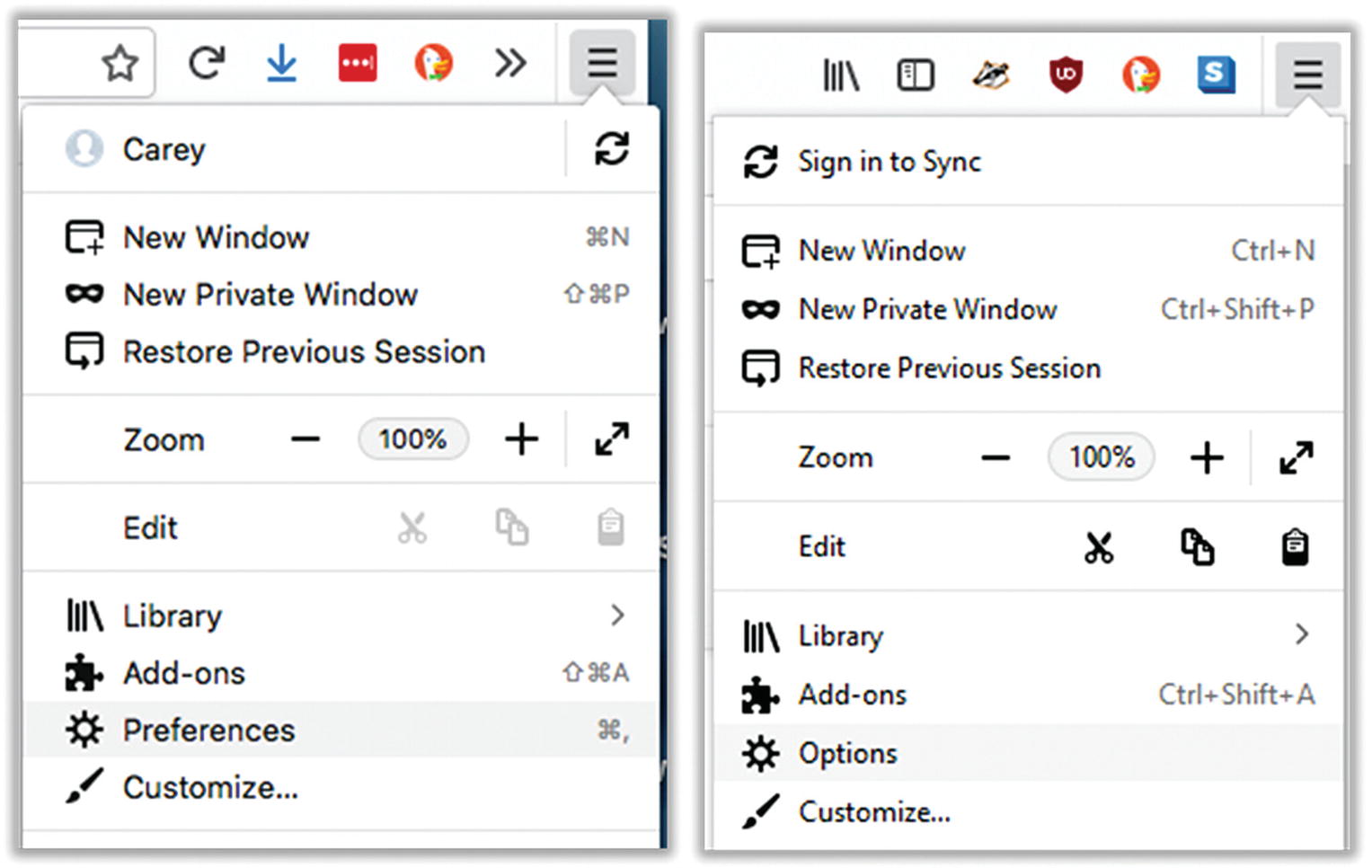 Figure 7-6
Figure 7-6Firefox preferences (left: Mac, right: Windows)
- 2.Select the Privacy & Security tab at the left. Under Forms & Passwords, be sure to uncheck “Remember logins and passwords”—we’ll be using LastPass for this. And if there are any saved passwords under Saved Logins... be sure to remove them all (Figure 7-7).
 Figure 7-7
Figure 7-7Firefox Forms & Passwords settings
- 3.Find Cookies and Site Data (Figure 7-8). Set “Accept third-party cookies and site data” to Never. The first option of “Accept cookies…” is for first-party cookies, and that’s fine as is.
 Figure 7-8
Figure 7-8Firefox Cookies and Site Data settings
- 4.Next, find Tracking Protection (Figure 7-9). Set it be always on. Turning on Do Not Track is just a suggestion to the web site, but still you should tell everyone that will listen that you don’t like being tracked.
 Figure 7-9
Figure 7-9Firefox Tracking Protection settings
- 5.Next, find Permissions (Figure 7-10). There are several settings here, and you should look at each of them individually. By far the safest thing is to block all requests to access your location, camera, and microphone. However, that will break some web sites. As long as Firefox prompts you for permission, you can leave these settings as the default. Just know that you can permanently deny or allow any site here. Below that, you should check all three boxes. This may require you to restart Firefox.
 Figure 7-10
Figure 7-10Firefox Permissions settings
- 6.Find Firefox Data Collection (Figure 7-11). You can decide what you want here. For maximum privacy, you should share nothing. But for Mozilla to improve its products, it has a legitimate need for some user data. But maybe they can just get that from someone else.
 Figure 7-11
Figure 7-11Firefox data collection and use settings
- 7.Finally, find the section Deceptive Content and Dangerous Software Protection under the Security section (Figure 7-12). I’m not sure how effective this is, but it’s worth a shot. I would check all the boxes.
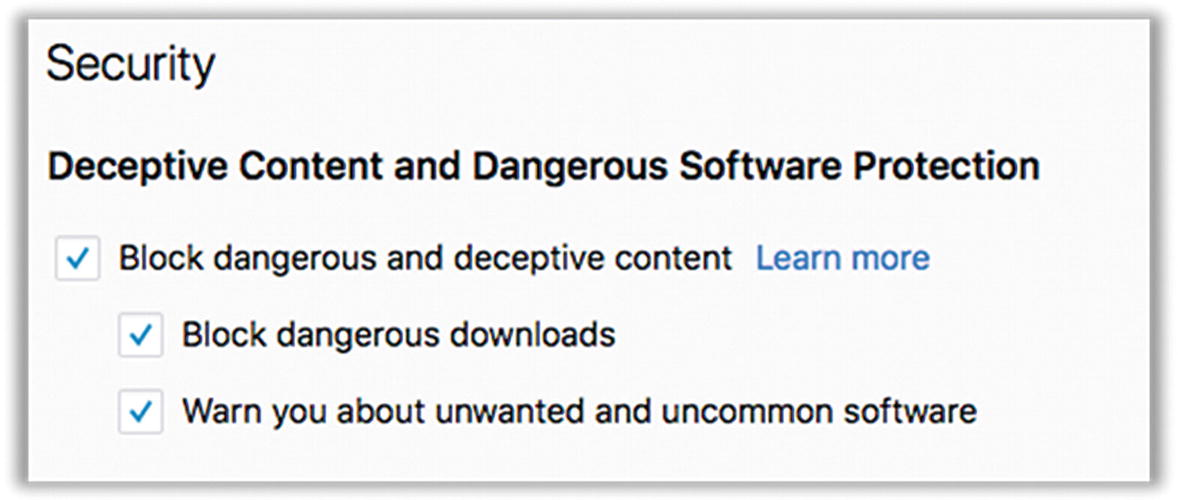 Figure 7-12
Figure 7-12Firefox security settings
Tip 7-2b. Chrome
- 1.
- 2.Scroll to the bottom and click the little Advanced button. In the “Privacy and security” section, set the options as shown in Figure 7-14. Many of the options here involve sending information about you to Google—and while they may be helpful services, they give away a lot of information about you.
 Figure 7-14
Figure 7-14Chrome “Privacy and security” settings
- 3.
At the bottom of this section, click “Content settings.” There are several settings here, and you should look at each of them individually. By far the safest thing is to block all requests to access your location, camera, and microphone. However, that will break some web sites. As long as Chrome asks you before accessing, you should be safe. Just know that you can permanently deny or allow any site here. The setting for Flash should also be defaulted to “Ask first.” That’s the setting you want here. The whole reason we have Chrome is to run Flash when we have to, but you still want to be asked first to be safest.
- 4.Also in “Content settings” you’ll see Cookies—click to open these settings. Be sure to block all third-party cookies. You’ll want to allow first-party cookies, though (the first option in Figure 7-15).
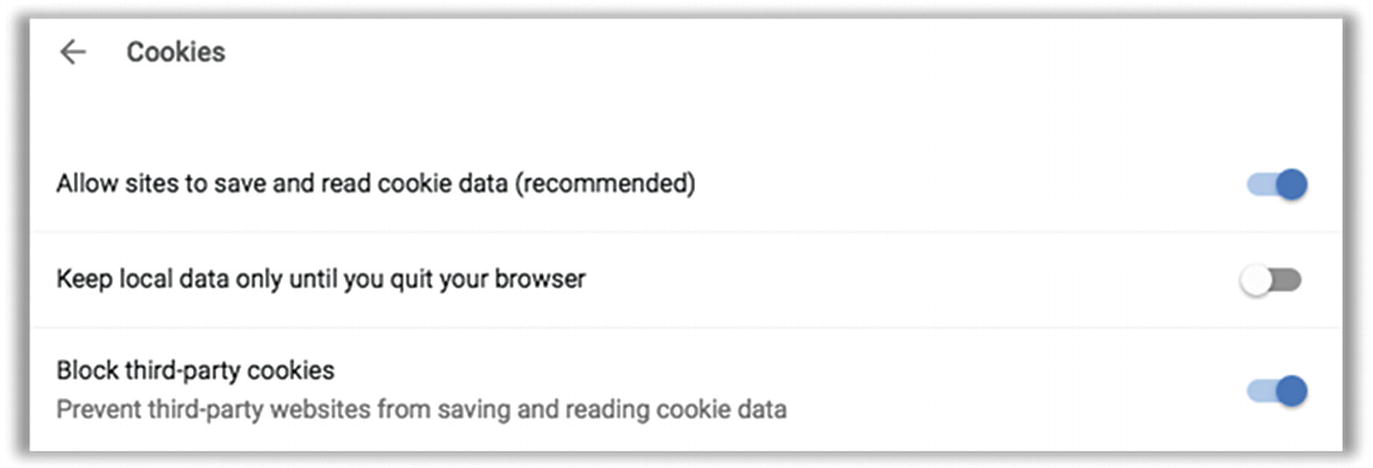 Figure 7-15
Figure 7-15Chrome Cookies settings
- 5.
Back to settings, find “Passwords and forms .” You should disable auto-fill of passwords here. And if there are any passwords saved here, you should delete them. (We’ll be using LastPass to save your passwords!)
Tip 7-3. Remove (or Disable) All Unnecessary Add-ons
Web browsers have become very flexible, allowing you to add all sorts of fun and useful features via plugins, add-ons, extensions, and toolbars. Unfortunately, these extras, many of which are free or get installed with other software, can open security holes and reduce your privacy. Toolbars are often the worst offenders, but any add-on can cause problems. Avoid them unless you really need them. (In the next section, I’ll give you some add-ons that will significantly enhance your security and privacy.) If you have any trouble removing an add-on, try searching for remove <add-on name> in your web browser. Some of these add-ons are tenacious and hard to remove (and these are the ones you most assuredly need to remove).
Note that Java is a plugin most people don’t need anymore. The Java plugin allows code inside your browser to run Java code outside your browser, and that’s generally bad. Having Java on your computer is fine, but there are few cases for regular users to invoke Java from within a web browser. So if you find a Java plugin, you can remove it. (Remember that JavaScript has nothing to do with Java, despite the similar names. JavaScript is widely used for good purposes, and disabling it would bring many web sites to a screeching halt.)
Tip 7-3a. Firefox
- 1.To remove an unwanted add-on to Firefox, first open the Add-ons menu from the general Firefox menu, which is off to the right (Figure 7-16).
 Figure 7-16
Figure 7-16Firefox add-ons menu
- 2.Select the Extensions tab at the left. Find the add-on that you want to remove and click the Remove button. (If you’re not sure, just click the Disable button for now and remove it later when you’re sure.) Figure 7-17 shows an example.
 Figure 7-17
Figure 7-17Firefox extension example
- 3.
You may need to restart your browser to complete this. If you have multiple add-ons to remove, you can remove them all and then just restart the browser once.
Tip 7-3b. Chrome
- 1.
To remove an unwanted add-on in Chrome, first open the Settings menu as we did previously (the menu at the upper right).
- 2.
- 3.Click REMOVE under the add-on you want to remove. (If you’re not sure, you can just disable it using the little switch at the bottom for now and remove it later once you’re sure.) Figure 7-19 shows an example.
 Figure 7-19
Figure 7-19Chrome extension example
- 4.
You may need to restart your browser to complete this. If you have multiple add-ons to remove, you can remove them all and the just restart the browser once.
Tip 7-4. Change the Default Search Option to DuckDuckGo
Even the venerable, ubiquitous Google search can (and will) track you. Think about some of the things you might search for and ask yourself if you would like that information saved and made available to someone else. That weird rash on your leg…how to hack your game console…where to find that special adult content…. If this idea bothers you, then you should consider changing your default browser search to DuckDuckGo.
To set DuckDuckGo as your default web browser search engine, the easiest way is to just install the DuckDuckGo Privacy Essentials plugin. Not only will this make DuckDuckGo your default search engine, it will also add some great privacy-protecting features to your browser. See the next tip for help with installing this and other great plugins.
Tip 7-5. Install Security and Privacy Add-ons
Some plug-ins actually enhance your security and privacy by preventing web sites from loading annoying ads and installing tracking cookies. (In fact, these plugins can significantly increase page-loading speed by avoiding lots of stuff you don’t need.) I recommend installing each of the following extensions. They each perform a slightly different function, though there is some overlap. I will walk you through installing one extension. The rest will follow the same procedure.
Note
The nature of most of these plugins is to block or restrict unwanted content. This can sometimes break web sites that haven’t been properly designed for the possibility that people might not want annoying ads, tracking cookies, etc. If you find a web site that is not working properly or somehow acting funny, you might try temporarily disabling some of these plugins. Some plugins allow you to “whitelist” web sites, which disables the blocking for sites you choose. Or you could also use the browser provided by Mac OS (Safari) or Windows (Internet Explorer) as a backup.
Let’s start with a plugin called Privacy Badger. There are a handful of effective plugins to block third-party tracking, but Privacy Badger is the only one I know of that was created by a purely nonprofit organization—and it happens to be a group that is strongly committed to protecting people: the Electronic Frontier Foundation (EFF).
Tip 7-5a. Firefox
- 1.
Open the Add-ons menu, as we did in the earlier tip.
- 2.
Using the Add-ons search bar (not the regular browser search bar), search for Privacy Badger and hit Enter.
- 3.
The top choice should be Privacy Badger from EFF. Click it to select it. Then click Add to Firefox. This will bring up a confirmation dialog; click Add.
Tip 7-5b. Chrome
- 1.
Installing it on Chrome is a little different. First, go to the Chrome Web Store, either by searching for that or by going to this link:
- 2.
In the search box at the upper left, search for privacy badger and hit Enter.
- 3.
Click the + Add to Chrome button and then click “Add extension” in the pop-up dialog.
LastPass . Even though we already installed LastPass in an earlier chapter, the browser plug-in was installed only for the browsers you had installed at that time. If you just now installed Firefox or Chrome, then you’re going to need to install the LastPass plug-in for that browser.
DuckDuckGo Privacy Essentials . Not only will this install some excellent privacy and security tools, it will set your default web search to be DuckDuckGo. If you just can’t stand using anything but Google for search, then you can skip this plugin. The others here will perform a lot of the same privacy functions. You can also change your search engine to something else at any time.
HTTPS Everywhere. Another great plugin from EFF that attempts to use HTTPS wherever possible. Some sites can do HTTPS but won’t do it unless you ask—this plugin makes sure that your browser asks for HTTPS by default. Note that some sites with mixed content (HTTP and HTTPS on the same page) may not work properly with this plugin, so you might try disabling this one first if you’re having trouble.
uBlock Origin . This plugin blocks web site advertising (and therefore tracking). You should note, however, that most free web sites stay in business by getting money from advertisers. You may want to consider enabling ads from web sites that you want to explicitly support. But keep in mind that it’s not just about ad revenue for your favorite site—it’s also about protecting your privacy and securing your computer from malvertising. (Don’t install uBlock; that’s different. You want uBlock Origin.)
Decentraleyes . It’s a little hard to describe what this one does in a few sentences. But many of the web pages you visit download a bunch of little helpers in the background to do fancy things. Just the act of fetching these little snippets of code can give away information about sites you visit—this plugin contains many of the most popular helpers so your web browser doesn’t need to get them.
Tip 7-6. Be Careful on “Shady” Sites
Some web sites are just way worse than others when it comes to malware, and those sites tend to be associated with what some would call vices…porn, gambling, copyrighted movie and music downloading, etc. I’m not here to judge. Just know that these sorts of sites tend to be worse than others, and the ones that are “free” are ones I’d worry about the most.
Tip 7-7. Beware of Pop-ups Offering/Requiring Plugins
Some web sites will ask/offer to install some malware checker or efficiency booster or video codec. If you get a pop-up window that wants to install something, just close the entire tab or window and walk away. If the plugin is something common like Flash, Java, Silverlight, or QuickTime, you should go directly to those web sites to download and install the plugin. Then return to the web site and see if it works. The rule is: if you didn’t go looking for something or request it yourself, don’t install it.
Tip 7-8. Opt Out Where You Can
This site has lots of great info: https://www.worldprivacyforum.org/2015/08/consumer-tips-top-ten-opt-outs/
Opting out of credit card offers: https://www.optoutprescreen.com/?rf=t
Opting out of online tracking: https://www.networkadvertising.org/choices/
Opting out of Google “interest-based” ads: https://www.google.com/ads/preferences/
National “do not call” registry: https://www.donotcall.gov/
Opting out of direct marketing mail and e-mail: https://www.dmachoice.org/#
Tip 7-9. Use Private or Incognito Browsing
Both Firefox and Chrome have a special “privacy mode” of web browsing. This mode is supposed to remove all local traces of your surfing once you close the special window—your browsing history, cookies, and anything else the browser might remember about your session. The key word here is local While it may successfully block some cookies from being stored permanently, it doesn’t make you anonymous or stealthy on the Web. Its only purpose is to hide what you’ve been doing from people who have access to your computer by deleting all the locally stored traces. To enable this mode, follow the next steps.
Tip 7-9a. Firefox
- 1.Open the Firefox menu and select New Private Window (Figure 7-20).
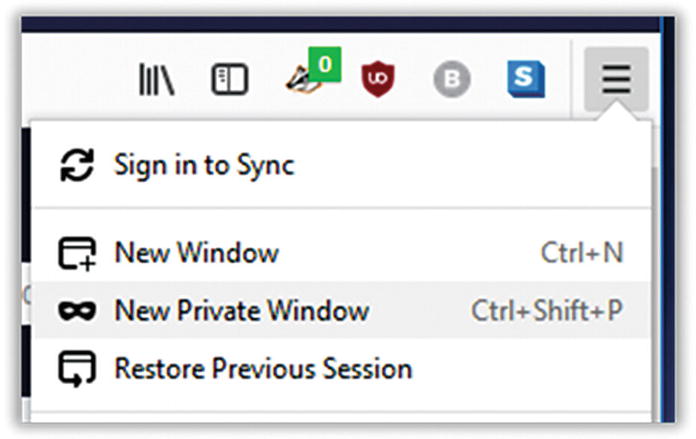 Figure 7-20
Figure 7-20Firefox New Private Window menu
- 2.
Do your private browsing in this window. When done, just close this window.
Tip 7-9b. Chrome
- 1.Open the Chrome menu and select “New incognito window” (Figure 7-21).
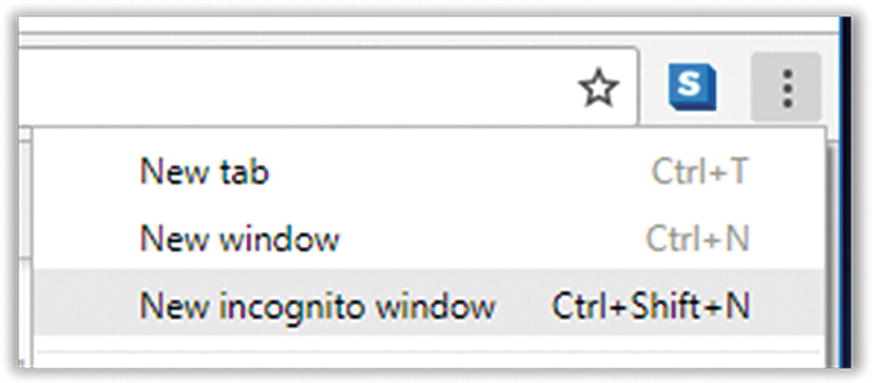 Figure 7-21
Figure 7-21Chrome “New incognito window” menu
- 2.
Do your private browsing in this window. When done, just close this window.
Tip 7-10. Change Your DNS Provider on Your Wi-Fi Router
This can be tricky because every Wi-Fi router’s admin page is a little different. I can’t give you a simple step-by-step for every possible router. In the previous chapter, I told you how to find your router’s admin IP address—use that same address to make these changes. You’ll need to look for the configuration for Domain Name Service (DNS) server. It should be prepopulated with a couple addresses—a primary and a backup. The first entry is the one it will try most times, but if that one fails, it will try the second one. The default addresses almost surely belong to the DNS provider used by your Internet service provider (ISP).
- Quad9 . This service has some built-in protection against known-malicious web sites. The information is updated constantly.
Primary: 9.9.9.9
Secondary: 149.112.112.112
- CloudFlare . The main benefit of this site is that it’s the only one offering DNS over HTTPS, which will obscure your requests (sort of like a VPN just for DNS).
Primary: 1.1.1.1
Secondary: 1.0.0.1
Tip 7-11. Change Your DNS Provider on Your Laptop
If you have a laptop, you should also set your DNS settings there because when you’re out and about, you’re no longer using your home’s Wi-Fi router.
Tip 7-11a. Windows 7/8.1
- 1.Open Control Panel. Click Network and Internet (Figure 7-22).
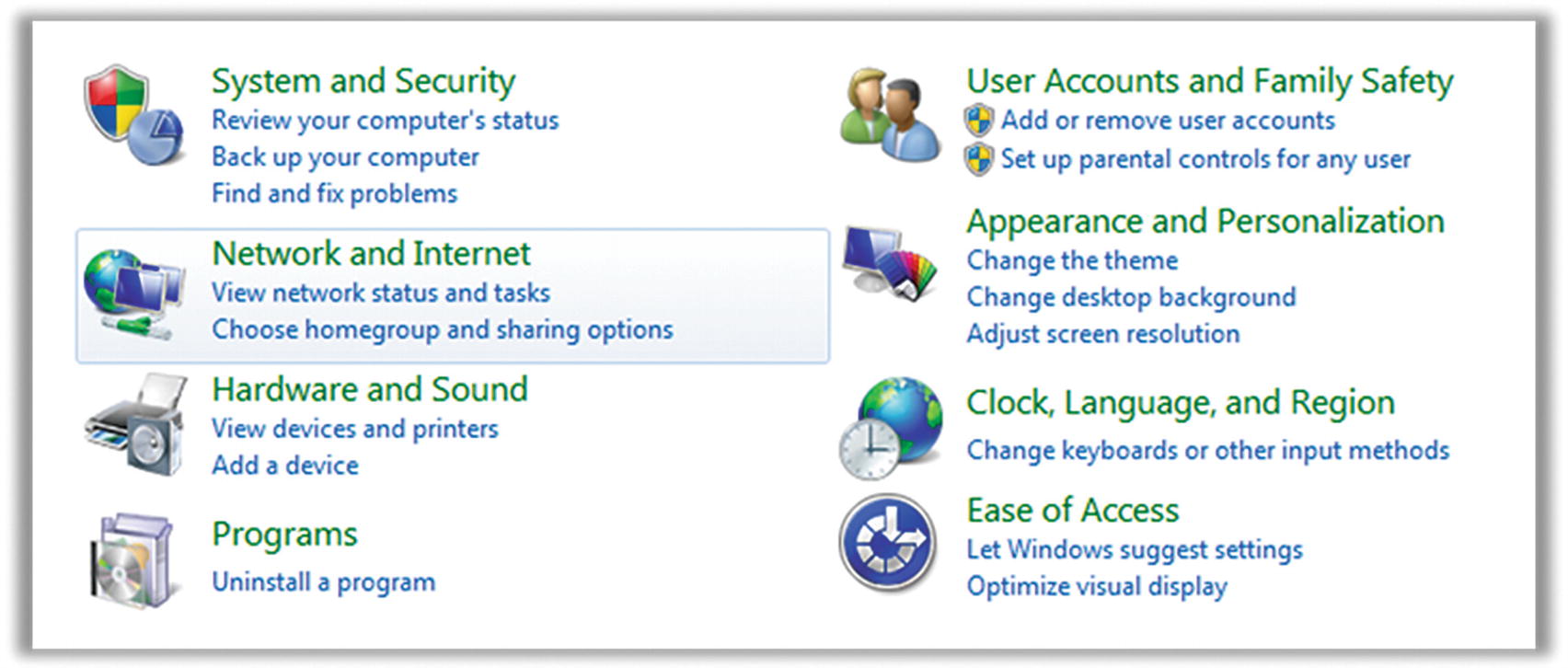 Figure 7-22
Figure 7-22Windows 7/8.1 Network and Internet settings
- 2.Under Network and Sharing Center, click “View network status and tasks” (Figure 7-23).
 Figure 7-23
Figure 7-23Windows 7/8.1 network status settings
- 3.Click “Change adapter settings” at the left (Figure 7-24).
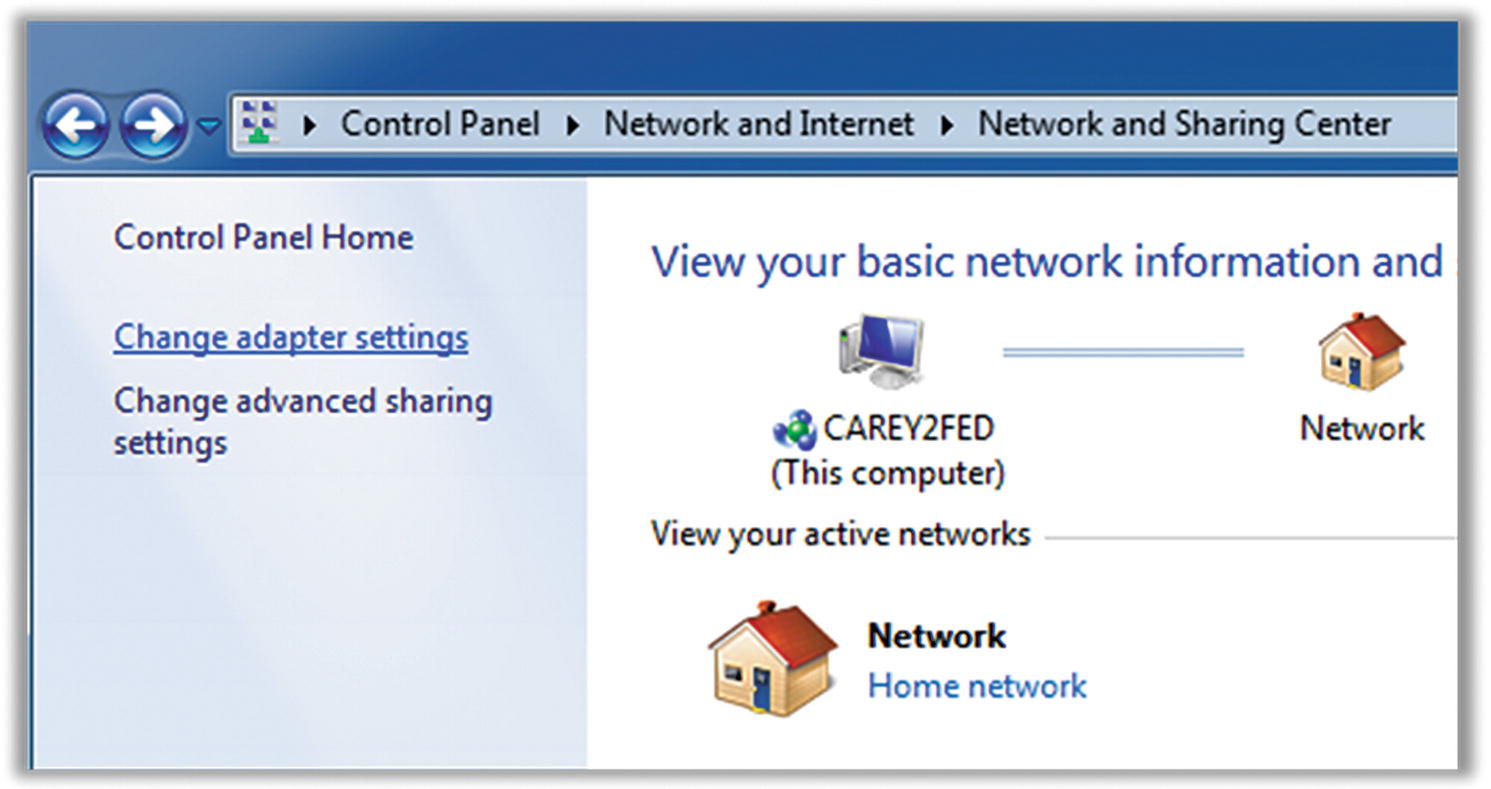 Figure 7-24
Figure 7-24Windows 7/8.1 “Change adapter settings” link
- 4.
The steps and screenshots from here out are basically identical to Windows 10. Skip ahead to Tip 7-11b, Step 4.
Tip 7-11b. Windows 10
- 1.Open Settings. Click Network & Internet (Figure 7-25).
 Figure 7-25
Figure 7-25Windows 10 Network & Internet settings
- 2.Click Network and Sharing Center (Figure 7-26).
 Figure 7-26
Figure 7-26Windows 10 Network and Sharing Center settings
- 3.Click “Change adapter settings” at the left (Figure 7-27).
 Figure 7-27
Figure 7-27Windows 10 “Change adapter settings” link
- 4.
You may see more than one connection here. You should probably change them all, but the primary one for laptops will be the Wi-Fi adapter. Repeat the following process for every one you want to change. Start by double-clicking the adapter you want to change.
- 5.
- 6.You’re probably going to want to change the IPv4 settings. (Someday we’ll all be using IPv6, but that time is a way off.) Find this and double-click it (Figure 7-29).
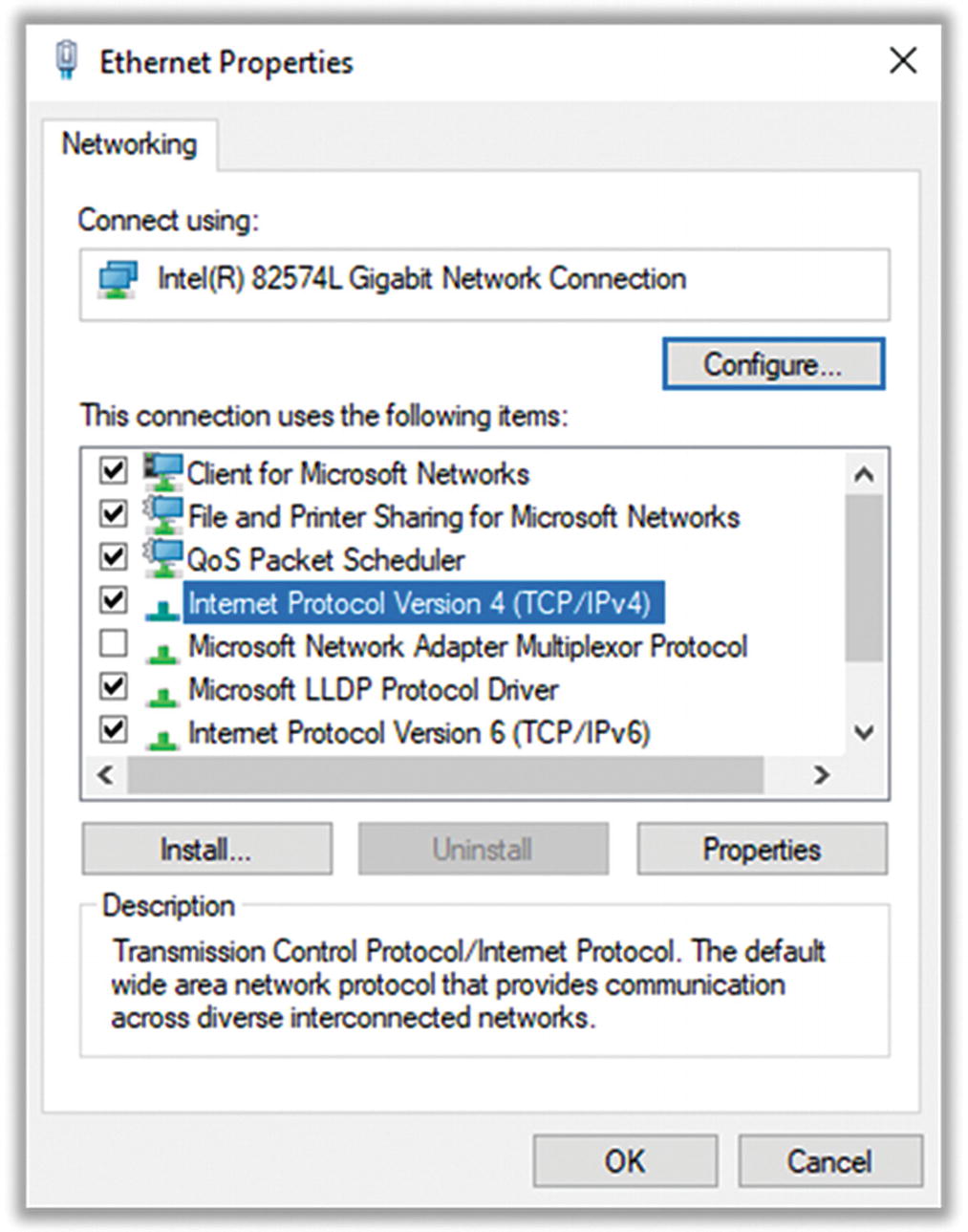 Figure 7-29
Figure 7-29Windows 10 network properties
- 7.Change the DNS server addresses to the ones you want (see the previous tip for info). You’ll need a primary and a backup pair. In Figure 7-30 I’ve shown the Quad9 addresses as an example.
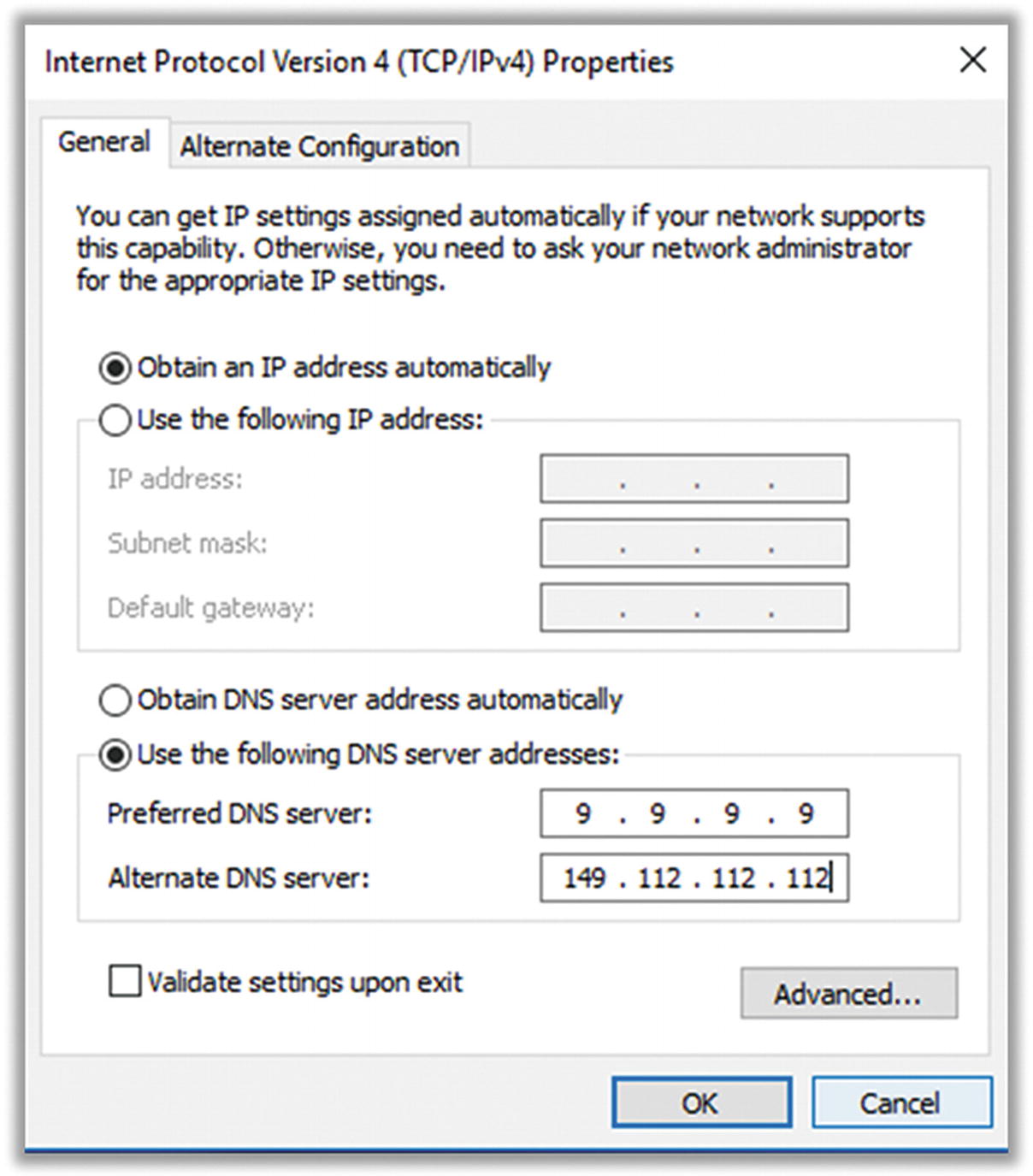 Figure 7-30
Figure 7-30Windows 10 example DNS settings
- 8.
Click OK or Close on all the windows to save the settings.
Tip 7-11c. Mac OS
- 1.Open System Preferences from the Apple menu. Find Network and click it (Figure 7-31).
 Figure 7-31
Figure 7-31Mac OS network settings
- 2.
If necessary, click the lock icon at the lower left and enter the admin username and password to unlock.
- 3.You may see more than one connection here. You should probably change them all, but the primary one for laptops will be the Wi-Fi adapter. Repeat the following process for every one you want to change. Start by selecting the adapter you want to change. Click the Advanced button at the lower right (Figure 7-32).
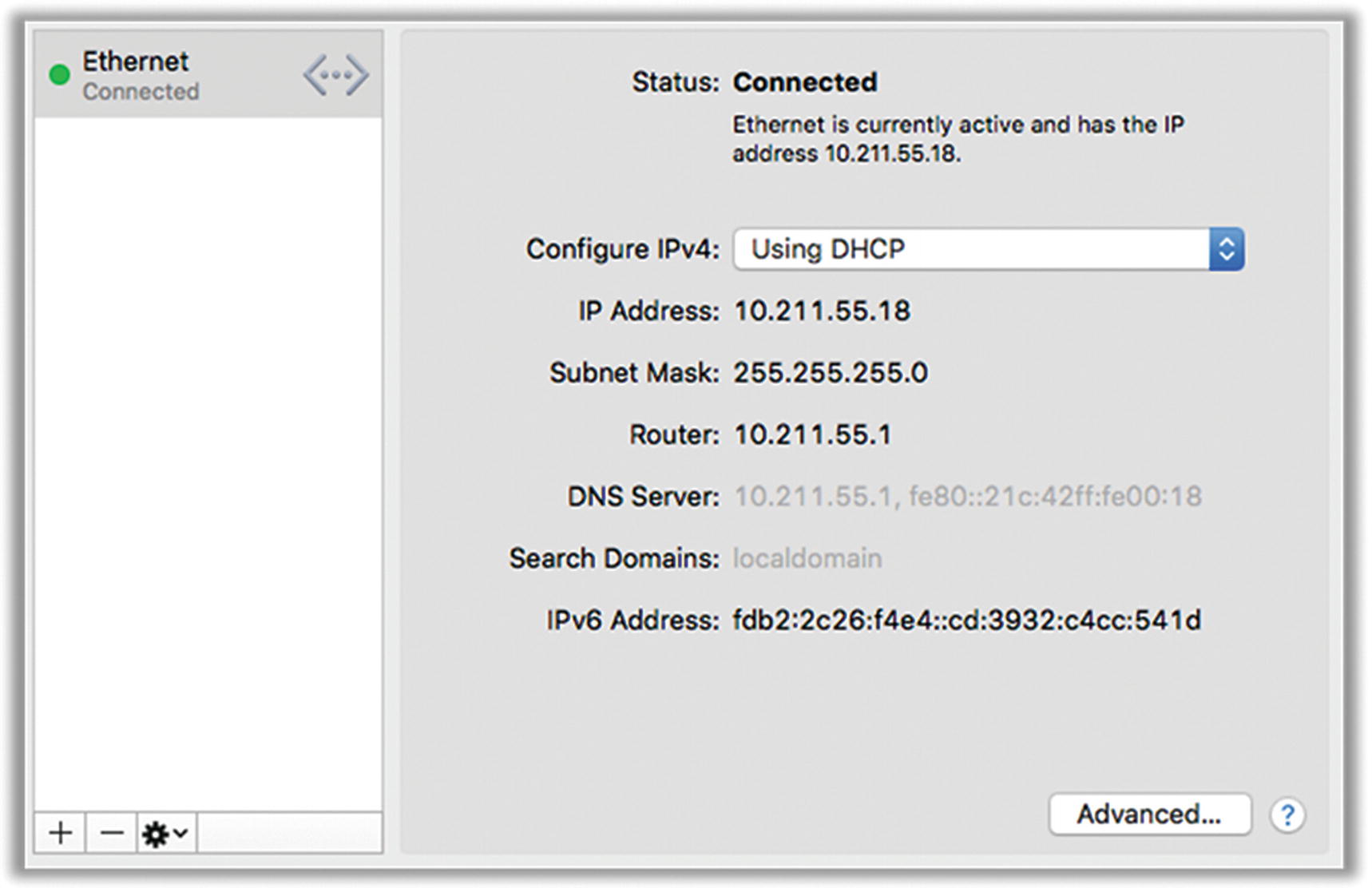 Figure 7-32
Figure 7-32Mac OS network adapter settings
- 4.Click the DNS tab. Remove the existing DNS servers at the left using the little minus button at the lower left. (Note that if these entries are automatic, you can’t directly remove them—they’ll disappear when you add the new ones.) Now add two more entries: the primary and backup DNS servers you want to use. Refer to the previous tip for two good options. Figure 7-33 shows Quad9 servers.
 Figure 7-33
Figure 7-33Mac OS example DNS settings
- 5.
Click OK here and then Apply.


